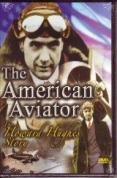![The Outlaw [1943]](/pictures/1041935.jpg) The Outlaw | DVD | (21/04/2003)
from £5.02
| Saving you £-1.03 (N/A%)
| RRP
The Outlaw | DVD | (21/04/2003)
from £5.02
| Saving you £-1.03 (N/A%)
| RRP Howard Hughes with the assistance of Howard Hawks directed this racy version of the Pat Garrett vs Billy The Kid story. The publicity campaign surrounding the film's release was a masterpiece. Armed with stills of 19-year-old Jane Russell revealing a remarkable dcolletage (while stopping to pick up a pair of milk pails!) producer/director Howard Hughes spent tens of thousands of dollars purposely to agitate the censors and arouse public indignation. He released the film independently in San Francisco in 1943 after United Artists refused to distribute it; it was quickly closed down by civic groups. Meanwhile legendary publicist Russell Birdwell leased thousands of billboards from coast to coast for three years plastering a suggestive photo of the scantily clad Russell reclining on a bed of hay gun in hand. By 1946 when Hughes finally re-released the film audiences flocked to theatres: Jane Russell was now a Hollywood star and you can see why!
![Tycoon (John Wayne) [1947]](/pictures/1041649.jpg) Tycoon (John Wayne) | DVD | (05/06/2006)
from £6.12
| Saving you £3.87 (63.24%)
| RRP
Tycoon (John Wayne) | DVD | (05/06/2006)
from £6.12
| Saving you £3.87 (63.24%)
| RRP An action-packed romantic movie about an engineer's attempt to build a railroad tunnel in the Andes Mountains. Johnny Munroe is a tough builder who along with partner Pop Mathews has been hired by tycoon Frederick Alexander to pull off the difficult task. Although Johnny and Pop think that it would be far easier to lay the train tracks on a bridge spanning a river Frederick insists on a tunnel.
![Whatever Happened To Aunt Alice? [1969]](/pictures/1013094.jpg) Whatever Happened To Aunt Alice? | DVD | (02/07/2001)
from £N/A
| Saving you £N/A (N/A%)
| RRP
Whatever Happened To Aunt Alice? | DVD | (02/07/2001)
from £N/A
| Saving you £N/A (N/A%)
| RRP What Ever Happened to Aunt Alice? sees a change of direction for Robert Aldrich's unofficial trilogy which all involve "ageing actresses" in macabre thrillers (What Ever Happened to Baby Jane? and Hush ... Hush, Sweet Charlotte). The busy Aldrich only produced What Ever Happened to Aunt Alice?, calling in TV director Lee H Katzin (a Mission: Impossible regular) to handle the megaphone. Aldrich also opted to shoot the film in pastel colours appropriate to the unusual Arizona desert setting rather than the gothic black and white of the earlier films. The film cast the less iconic Geraldine Page as the genteelly unpleasant Mrs Clare Marrable. Left apparently penniless by her departed husband, Mrs M opts to keep up appearances by hiring a succession of timid elderly housekeepers, bossing them around with well-spoken nastiness, duping them out of their life savings and, on the pretence of getting help with a midnight tree-planting program, lures them into their own graves, batters them to death and plants lovely pines over them. Page gets her own way with the meek likes of Mildred Dunnock, until the feistier, red-wigged R!uth Gordon applies for the job and gets down to amateur sleuthing. While Bette Davis and her partners went wildly over the top in previous films, Page and Gordon play more subtly, finding odd pathetic moments in between the monstrous, irony-laced horror stuff. The supporting cast of pretty or handsome young things, mostly putty in the hands of the manipulative Page, contribute striking little cameos (Rosemary Forsyth sports a pleasing 1969 hairdo as the kindly but intimidated neighbour), but the film belongs to its leading ladies, delivering a fine line in twist-packed cat-and-mouse theatrics. The video is handsomely letterboxed, as befits a film made before widescreen films were shot with all the action in the middle of the frame to facilitate television sales. --Kim Newman
![The Outlaw [1943]](/pictures/1003298.jpg) The Outlaw | DVD | (12/04/2005)
from £12.23
| Saving you £-6.24 (N/A%)
| RRP
The Outlaw | DVD | (12/04/2005)
from £12.23
| Saving you £-6.24 (N/A%)
| RRP The publicity campaign surrounding The Outlaw's release was a masterpiece. Armed with stills of 19-year-old Jane Russell revealing a remarkable dcolletage (while stopping to pick up a pair of milk pails!) Producer/Director Howard Hughes spent tens of thousands of dollars purposely to agitate the censors and arouse public indignation. He released the film independently in San Francisco in 1943 after United Artists refused to distribute it; it was quickly closed down by civic groups.
![The Outlaw [1943]](/pictures/1002507.jpg) The Outlaw | DVD | (09/06/2003)
from £N/A
| Saving you £N/A (N/A%)
| RRP
The Outlaw | DVD | (09/06/2003)
from £N/A
| Saving you £N/A (N/A%)
| RRP Jane Russell plays a busty siren who steals the heart of Billy the Kid in this Howard Hughes directed story which centres on the rivalrous tentative friendships between Billy Doc Holiday and Pat Garrett.THIS VERSION CONTAINS EROTIC SCENES BANNED IN 1941.
 Howard Hughes Story | DVD | (20/08/2007)
from £29.14
| Saving you £-6.15 (-26.80%)
| RRP
Howard Hughes Story | DVD | (20/08/2007)
from £29.14
| Saving you £-6.15 (-26.80%)
| RRP The factual biography of the man who as a boy designed aeroplanes and went on to build a business empire of airlines hotels ans casinos and as a filmmaker produced some of Hollywood's most enduring films including Hell's Angels Scarface and The Outlaw. Yet behind the glamour the fame and the fabulous there lurked a darker side a sick isolated and deeply unhappy man who hid behind his image and ended up a prisoner of his own insanity.

Please wait. Loading...
This site uses cookies.
More details in our privacy policy